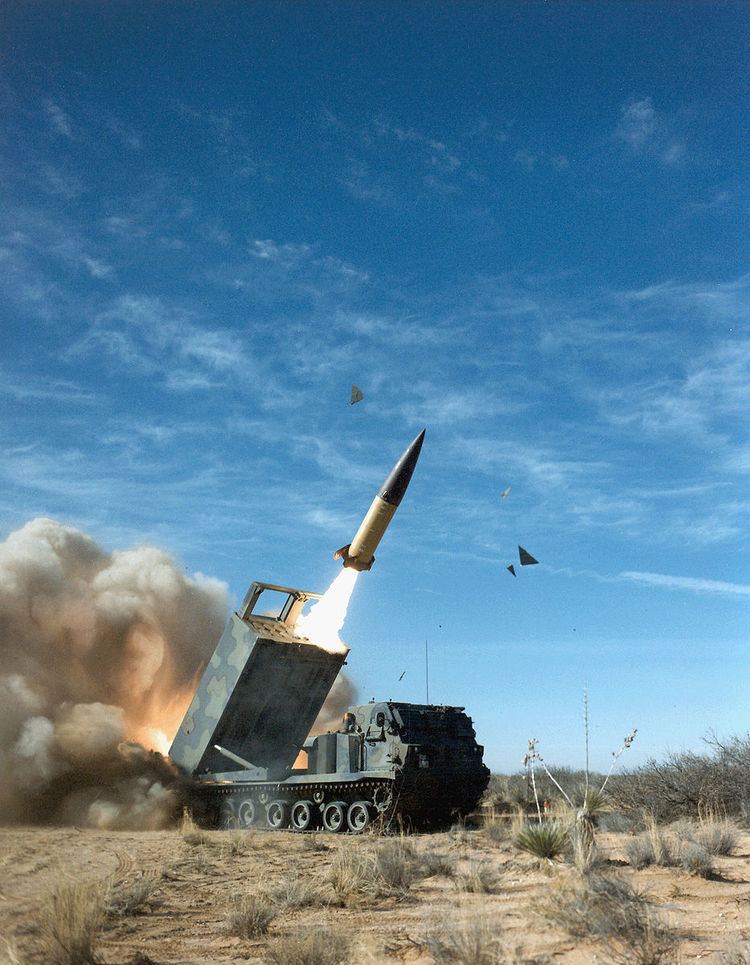Designer Ling-Temco-Vought | Designed 1986 | |
 | ||
Type Rocket artillery, tactical ballistic missile Place of origin United States of America Used by United States, South Korea Wars Gulf War, Iraq War, War in Afghanistan | ||
The MGM-140 Army Tactical Missile System (ATacMS) is a surface-to-surface missile (SSM) manufactured by Lockheed Martin. It has a range of over 160 kilometres (100 mi), with solid propellant, and is 4.0 metres (13 ft) high and 610 millimetres (24 in) in diameter.
Contents
- MGM 140A Block I
- MGM 140B Block IA
- MGM 164 ATacMS Block II
- MGM 168 ATacMS Block IVA
- Future
- Current operators
- References
The ATACMS can be fired from multiple rocket launchers, including the M270 MLRS, and HIMARS. An ATACMS launch container has a lid patterned with six circles like a standard MLRS rocket lid.
The first use of the ATACMS in a combat capability was during Operation Desert Storm, where a total of 32 were fired from the M270 MLRS. During the Operation Iraqi Freedom more than 450 missiles were fired. As of early 2015, over 560 ATACMS missiles had been fired in combat.
MGM-140A – Block I
Previously M39, unguided missile contains 950 M74 anti-personnel/anti-materiel (APAM) submunitions with a range of 128 kilometres (80 mi).
MGM-140B – Block IA
Previously M39A1, missile uses GPS/INS guidance, carries 275 M74 submunitions and has a 165 kilometres (103 mi) range.
MGM-164 ATacMS – Block II
A Block II variant (initially designated MGM-140C or, previously, M39A3) was designed to carry a payload of 13 Brilliant Anti-Tank (BAT) munitions manufactured by Northrop Grumman. However, in late 2003 the U.S. Army terminated the funding for the BAT-equipped ATACMS and therefore the MGM-164A never became fully operational.
MGM-168 ATacMS – Block IVA
Originally designated Block IA Unitary (MGM-140E), the new Block IVA variant substitutes a 230 kilograms (500 lb) unitary HE warhead for M74 bomblets. It uses the same GPS/INS guidance as the MGM-140B. The development contract was placed in December 2000, and flight-testing began in April 2001. The first production contract was awarded in March 2002. The range has been increased to some 300 kilometres (190 mi), limited more by the legal provisions of the Missile Technology Control Regime (MTCR) than technical considerations.
Future
In 2007, the Army terminated the ATACMS program due to cost, ending the ability to replenish stocks. To sustain the remaining inventory, the ATACMS Service Life Extension Program (SLEP) was launched, which refurbishes or replaces propulsion and navigation systems, replaces cluster munition warheads with the unitary blast fragmentation warhead, and adds a proximity fuze option to obtain area effects; deliveries are projected to start in 2018. The ATACMS SLEP is a bridging initiative to provide time to complete analysis and development of a successor capability to the aging ATACMS stockpile, which could be ready around 2022.
In January 2015, Lockheed Martin received a contract to develop and test new hardware for Block I ATACMS missiles to eliminate the risk of unexploded ordnance by 2016. The first modernized Tactical Missile System (TACMS) was delivered on 28 September 2016 with updated guidance electronics and added capability to defeat area targets using a unitary warhead without leaving behind unexploded ordnance.
In October 2016, it was revealed that the ATACMS would be upgraded with an existing seeker to enable it to strike moving targets on land and at sea.
In March 2016, Lockheed Martin, Boeing, and Raytheon announced they would offer a missile to meet the U.S. Army's Long-Range Precision Fires (LRPF) requirement to replace the ATACMS. The missile will use advanced propulsion to fly faster and further, out to 500 kilometres (310 mi) (limited by the Intermediate-Range Nuclear Forces Treaty), while also being thinner and sleeker, increasing loadout to two per pod, doubling the number able to be carried by M270 MLRS and M142 HIMARS launchers. One contractor is to be downselected in 2018-19 to begin production in 2021-22.
